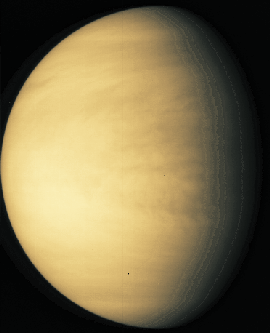Venus: Earth's Sister Planet

Credit & Copyright: NASA,
Galileo,
Copyright Calvin J. Hamilton
Explanation:
This picture in visible light was taken by the
Galileo spacecraft.
Venus is very similar to
Earth in size and mass - and so is sometimes referred to as
Earth's sister planet - but Venus has a quite different climate.
Venus'
thick clouds and closeness to the
Sun (only
Mercury is closer) make it the hottest planet - much hotter than
the Earth. Humans could not survive
there, and no life of any sort has ever been found. When
Venus is visible
it is usually the brightest object in the sky after the Sun and the Moon.
More than 20 spacecraft have visited Venus including
Venera 9, which landed on the surface, and
Magellan, which used radar to peer through the clouds
and make a map of the surface. There are still many things about Venus's
unusual atmosphere that astronomers don't understand.
Authors & editors:
Robert Nemiroff
(MTU) &
Jerry Bonnell
(USRA)
NASA Web Site Statements, Warnings,
and Disclaimers
NASA Official: Jay Norris.
Specific
rights apply.
A service of:
LHEA at
NASA /
GSFC
& Michigan Tech. U.

